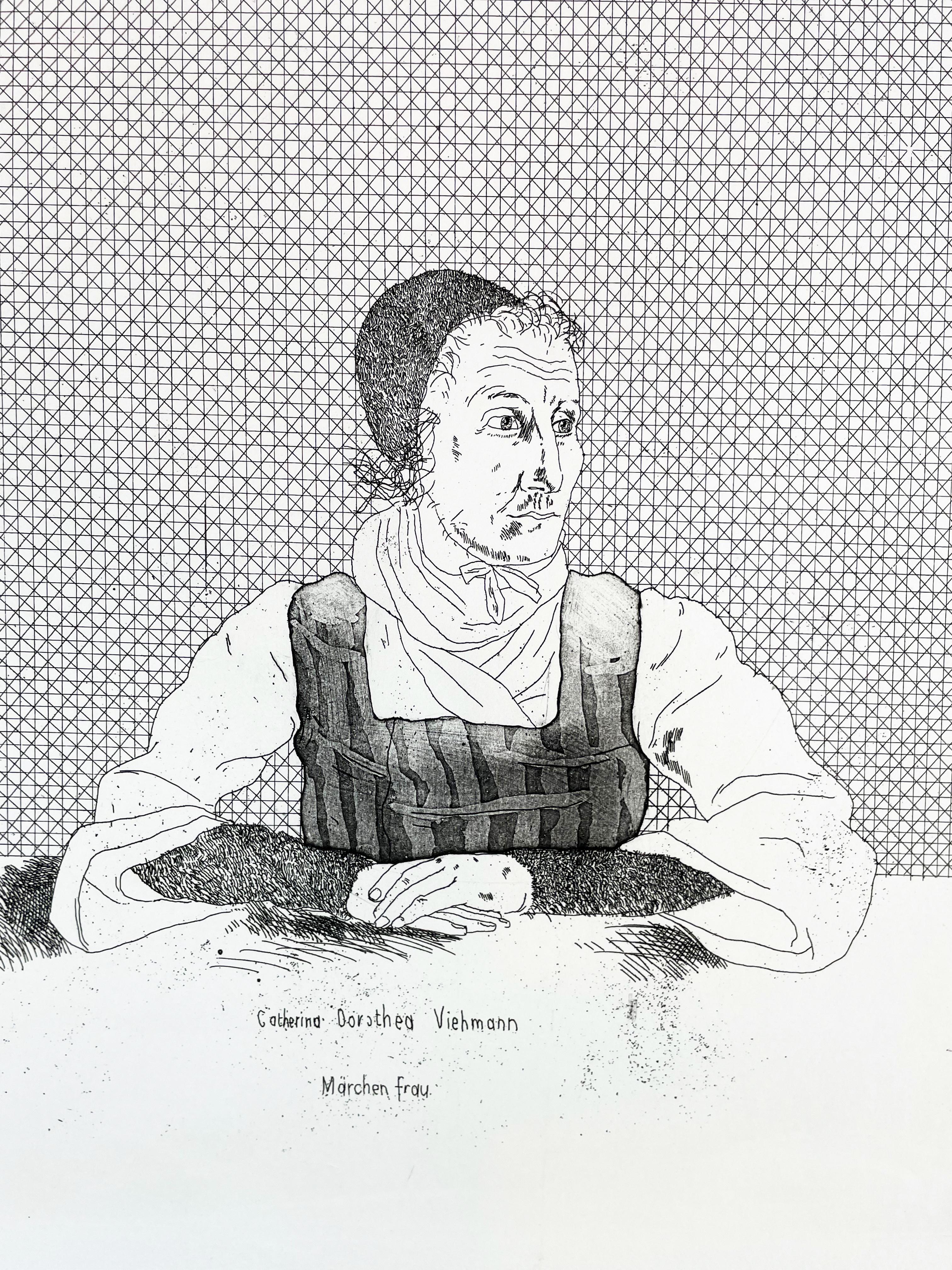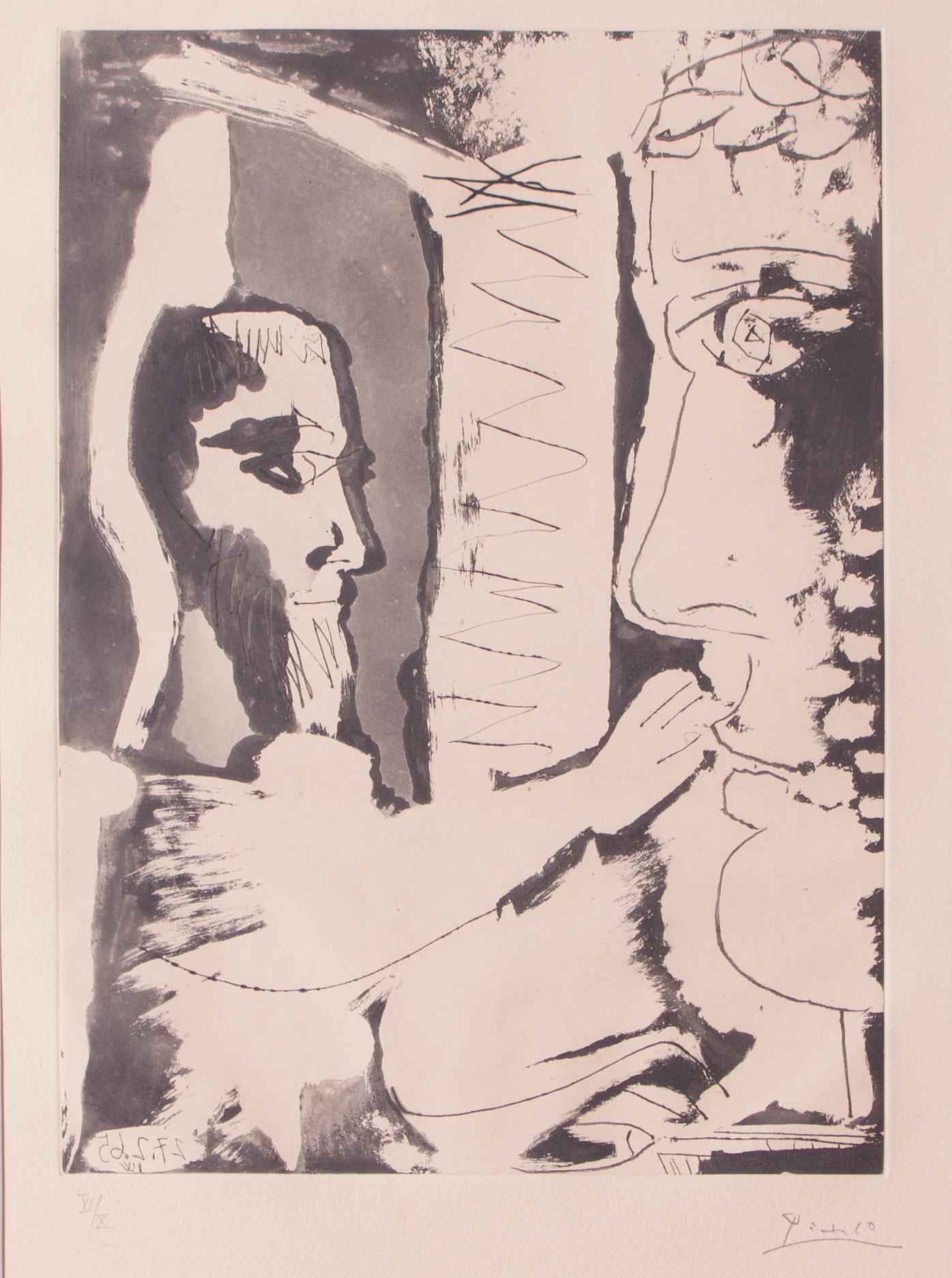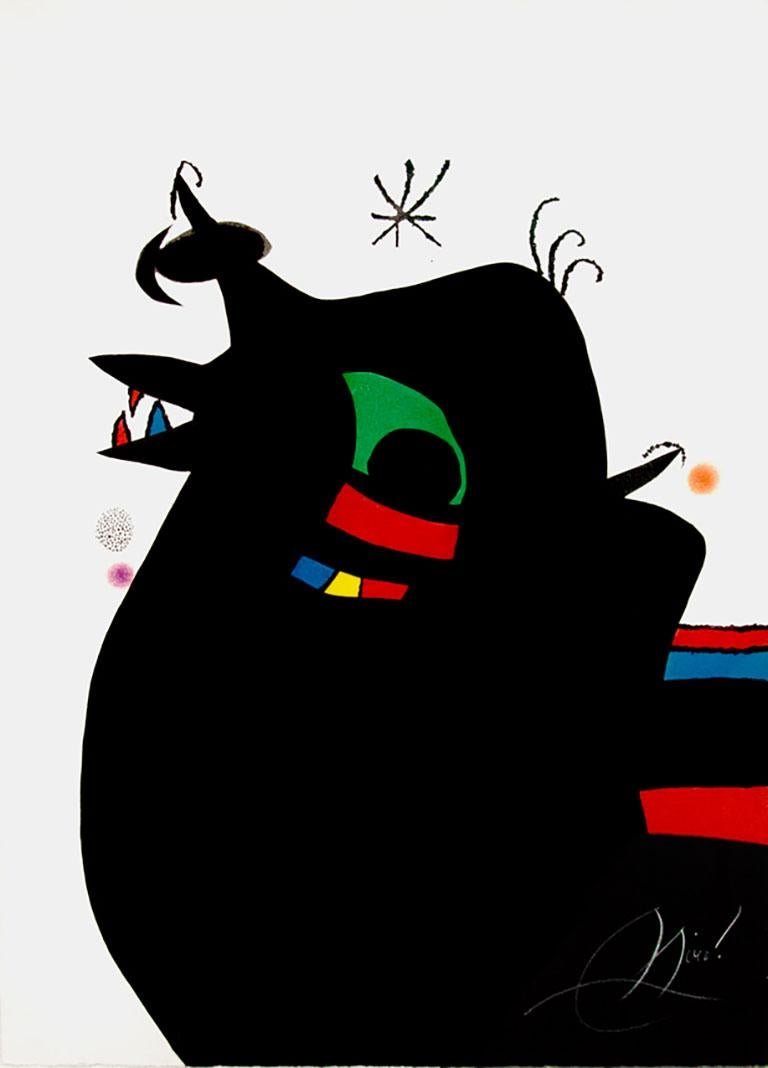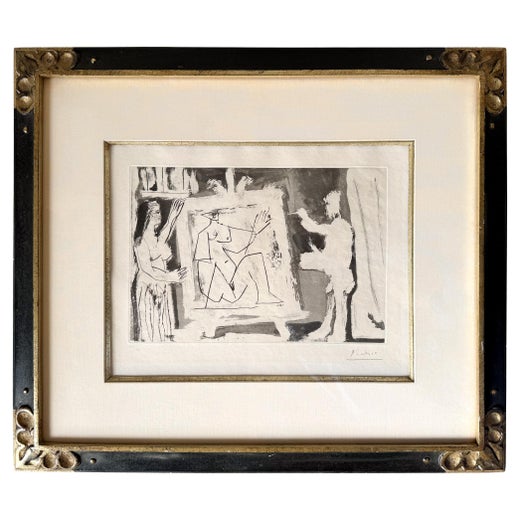Pablo PicassoPeintre et Modele1966
1966
About the Item
- Creator:Pablo Picasso (1881-1973, Spanish)
- Creation Year:1966
- Dimensions:Height: 10.88 in (27.64 cm)Width: 15.25 in (38.74 cm)
- Medium:
- Movement & Style:
- Period:
- Condition:
- Gallery Location:Fairlawn, OH
- Reference Number:
Pablo Picasso
One of the most prolific and revolutionary artists the world has ever seen, Pablo Picasso had a tremendous impact on the development of 20th-century modern art. Although he is best known for his association with the Cubist movement, which he founded with Georges Braque, Picasso’s influence extends to Surrealism, neoclassicism and Expressionism.
“Every act of creation is, first of all, an act of destruction,” the Spanish artist proclaimed. In Picasso's Cubist paintings, he emphasizes the two-dimensionality of the canvas, breaking with conventions regarding perspective, foreshortening and proportion. Picasso was inspired by Iberian and African tribal art. One of his most famous pre-Cubist works is Les Demoiselles d’Avignon (1907), a painting considered immoral and shocking at the time for its depiction of nude women whose faces resemble Iberian tribal masks.
Picasso made many portraits in this style, most often of the women in his life, their expressively colored faces composed of geometric shards of surface planes. In Woman in a Hat (Olga), 1935, he painted his first wife as an assemblage of abstract forms, leaving the viewer to decipher the subject through the contrasting colors and shapes. Picasso was a tireless artist, creating more than 20,000 paintings, drawings, prints, ceramics and sculptures. Tracing his life’s work reveals the progression of modern art, on which he had an unparalleled influence.
Browse an expansive collection of Pablo Picasso's art on 1stDibs.
- ShippingRetrieving quote...Ships From: Fairlawn, OH
- Return PolicyA return for this item may be initiated within 10 days of delivery.
- L'Aieule (The Grandmother)By Louis LegrandLocated in Fairlawn, OHL'Aieule (The Grandmother) Etching and aquatint printed in colors, 1904 Signed with the red stamp of the publisher, Gustave Pellet, Lugt 1193 and numbered (see photo) Edition: 100 (81/100) Reference: Arwas 202 iv/IV IFF 98 Condition: Excellent, the sheet aged as usual Image size: 14 1/4 x 18 5/8" Sheet size: 16 15/16 x 24 1/4" Louis Auguste Mathieu Legrand (29 September 1863 – 1951) was a French artist, known especially for his aquatint engravings, which were sometimes erotic. He was awarded the Légion d'honneur for his work in 1906. Life Legrand was born in the city of Dijon in the east of France. He worked as a bank clerk before deciding to study art part-time at Dijon's Ecole des Beaux-Arts. He won the Devosge prize at the school in 1883.[2] In 1884 Legrand studied engraving under the Belgian printmaker Félicien Rops. Legrand's artworks include etchings, graphic art and paintings. His paintings featured Parisian social life. Many were of prostitutes, dancers and bar scenes, which featured a sense of eroticism. According to the Hope Gallery, "Louis Legrand is simply one of France's finest early twentieth century masters of etching." His black and white etchings especially provide a sense of decadence; they have been compared to those of Henri de Toulouse-Lautrec, though his drawings of the Moulin Rouge, the can-can dance and the young women of Montmartre preceded Toulouse-Lautrec's paintings of similar scenes. He made over three hundred prints of the night life of Paris. They demonstrate "his remarkable powers of observation and are executed with great skill, delicacy, and an ironic sense of humor that pervades them all." Two of his satirical artworks caused him to be tried for obscenity. The first, "Prostitution" was a symbolic drawing which depicted a naked girl being grasped by a dark monster which had the face of an old woman and claws on its hands; the second, "Naturalism", showed the French novelist Émile Zola minutely studying the thighs of a woman with a magnifying glass. Defended by his friend the lawyer Eugène Rodrigues-Henriques (1853–1928), he was found not guilty in the lower court, but was convicted in the appeal court and then given a short prison sentence for refusing to pay his fine. Legrand was made famous by his colour illustrations for Gil Blas magazine's coverage of the can-can, with text by Rodrigues (who wrote under the pseudonym Erastene Ramiro). It was a tremendous success, with the exceptional quantity of 60,000 copies of the magazine being printed and instantly sold out in 1891. In 1892, at the instigation of the publishing house Dentu, Legrand made a set of etchings of his Gil Blas illustrations. The etchings were published in a book, Le Cours de Danse Fin de Siecle (The End of the Century Dance Classes). Legrand took a holiday in Brittany, which inspired him to engrave a set of fourteen lithographs of simple country life called Au Cap de la Chevre (On Goat Promontory). It was published by Gustave Pellet who became a close friend of Legrand's. Pellet eventually published a total of 300 etchings by Legrand, who was his first artist; he also published Toulouse-Lautrec and Félicien Rops among others. He did not only work in graphics; he exhibited paintings at the Paris salon of the Société Nationale des Beaux-Arts starting in 1902. In 1906 he was made a chevalier of the Légion d'honneur. Legrand died in obscurity in 1951. A retrospective exhibition was held at the Félicien Rops museum in Namur, Belgium in 2006 to celebrate his graphic art. The art collector Victor Arwas published a catalogue raisonné for the occasion. Books illustrated de Maupassant, Guy: Cinq Contes Parisiens, 1905. Poe, Edgar Alan: Quinze Histoires d'Edgar Poe...Category
Early 1900s Art Nouveau Figurative Prints
MaterialsAquatint
- Danseuses s'habillant (Laurence adjusting her hair and Mignon adjusting clothesBy Louis LegrandLocated in Fairlawn, OHDanseuses s'habillant (Laurence adjusting her hair and Mignon adjusting hre clothes) Drypoint & aquatint, 1893 Signed in the plate (see photo) After the division of the plate into A. 81 (as here) and A. 82 Divant la glace Editon 100 printed on velin paper Issued by Pellet in the set, Les Petites du Ballet, Gustave Pellet editeur, 1893 (13 plates), second state (b) without remarque Reference: Arwas 81, top portion of the plate vii/VIII Plate/Image size: 6 x 8 7/16 inches Condition: excellent Louis Auguste Mathieu Legrand (29 September 1863 – 1951) was a French artist, known especially for his aquatint engravings, which were sometimes erotic. He was awarded the Légion d'honneur for his work in 1906. Life Legrand was born in the city of Dijon in the east of France. He worked as a bank clerk before deciding to study art part-time at Dijon's Ecole des Beaux-Arts. He won the Devosge prize at the school in 1883.[2] In 1884 Legrand studied engraving under the Belgian printmaker Félicien Rops. Legrand's artworks include etchings, graphic art and paintings. His paintings featured Parisian social life. Many were of prostitutes, dancers and bar scenes, which featured a sense of eroticism. According to the Hope Gallery, "Louis Legrand is simply one of France's finest early twentieth century masters of etching." His black and white etchings especially provide a sense of decadence; they have been compared to those of Henri de Toulouse-Lautrec, though his drawings of the Moulin Rouge, the can-can dance and the young women of Montmartre preceded Toulouse-Lautrec's paintings of similar scenes. He made over three hundred prints of the night life of Paris. They demonstrate "his remarkable powers of observation and are executed with great skill, delicacy, and an ironic sense of humor that pervades them all." Two of his satirical artworks caused him to be tried for obscenity. The first, "Prostitution" was a symbolic drawing which depicted a naked girl being grasped by a dark monster which had the face of an old woman and claws on its hands; the second, "Naturalism", showed the French novelist Émile Zola minutely studying the thighs of a woman with a magnifying glass. Defended by his friend the lawyer Eugène Rodrigues-Henriques (1853–1928), he was found not guilty in the lower court, but was convicted in the appeal court and then given a short prison sentence for refusing to pay his fine. Legrand was made famous by his colour illustrations for Gil Blas magazine's coverage of the can-can, with text by Rodrigues (who wrote under the pseudonym Erastene Ramiro). It was a tremendous success, with the exceptional quantity of 60,000 copies of the magazine being printed and instantly sold out in 1891. In 1892, at the instigation of the publishing house Dentu, Legrand made a set of etchings of his Gil Blas illustrations. The etchings were published in a book, Le Cours de Danse Fin de Siecle (The End of the Century Dance Classes). Legrand took a holiday in Brittany, which inspired him to engrave a set of fourteen lithographs of simple country life called Au Cap de la Chevre...Category
1890s Art Nouveau Figurative Prints
MaterialsAquatint
- SevillanasLocated in Fairlawn, OHSevillanas Etching and color aquatint on laid watermarked paper, c. 1900 Signed by the artist in pencil lower right (see photo) Editioned in pencil lower left corner of sheet Publish...Category
Early 1900s Post-Impressionist Figurative Prints
MaterialsAquatint
- De trace de pas de trace de…By Roberto MattaLocated in Fairlawn, OHSigned in pencil lower right Color etching with aquatint From: Monsour and Matta, Les Damnations, 1966 (11 plates, this one of 7 hors text images) Edition: 85 portfolios in the re...Category
1960s Surrealist Abstract Prints
MaterialsEtching, Aquatint
- Ballerine (Ballerina)By Georges RouaultLocated in Fairlawn, OHBallerine (Ballerina) Lift ground aquatint over heliogravure, printed in color, 1930 Unsigned (as issued) From: Andre Suares, Cirque (Livre d’Artiste with 8 plates), 1930 Published ...Category
1930s French School Figurative Prints
MaterialsAquatint
- Son avocat, en phrases creuses, clame sa totale inconscience (His lawyer, ...By Georges RouaultLocated in Fairlawn, OHSon avocat, en phrases creuses, clame sa totale inconscience (His lawyer, in hollow phrases, proclaims his total indiffference) Aquatint, drypoint, roulette and burnishing over heliogravure, 1922 Unsigned (as issued) From: Miserere (Have Mercy), 58 plates Plate 19 Aquatint, drypoint, roulette and burnishing over heliogravure 1922-1927 Edition: 425 on Arches vellum with the Ambrose Vollard watermark 25 Hors commerce portfolios All published impression are unsigned, as issued Signed and numbered only on the colophon Published by Societe d’Editions l’Etoile Filante, Paris, 1948 Printer: Jacquemin, Paris, 1922-1927 Reference: Chapon & Rouault 72 c/c Condition: excellent Image/Plate size: 21 1/16 x 15 7/8 Rouault’s Miserere...Category
1920s French School Figurative Prints
MaterialsAquatint
- Catherina Dorothea Viehman (Six Fairy Tales from the Brothers Grimm) HockneyBy David HockneyLocated in New York, NYCatherina Dorothea Viehman (from Six Fairy Tales from the Brothers Grimm) Etching and aquatint on W S Hodgkinson paper watermarked "DH" and "PP" Paper 1...Category
1960s Modern Figurative Prints
MaterialsAquatint, Etching
- Rapunzel, Rapunzel let down your Hair (Six Fairy Tales from the Brothers Grimm)By David HockneyLocated in New York, NYSheet from “Rapunzel” story (from Six Fairy Tales from the Brothers Grimm) Text printed letterpress and “Rapunzel, Rapunzel let down your Hair” etching and aquatint on W S Hodgkinson paper watermarked "DH" and "PP" Etching 10.5 × 9.85 in. / 26.7 × 25 cm Paper 17.5 x 12.25 in. / 45 x 31 cm Unsigned: apart from the published edition of 400 books and 100 portfolios. This is one of eleven images recently found in our archive which we have decided to make available. There is one only of each image. Perhaps the most famous story from the Grimm Brothers, Rapunzel spins the tale of a beautiful young princess locked away by an evil sorceress. Captured in this scene is the moment a King's son came across the tower and fell in love with her sweet singing, beseeching her: 'Rapunzel, Rapunzel, Let down your hair to me.' Though the sorcerer banishes Rapunzel and maims the prince, they are of course ultimately reunited to live happily together. Hockney illustrates this scene with incredible texture detail: layers of aquatint defining the soft forest floor, delicate hatching on the horse's haunch, the tower's tight crosshatching, and of course the lyrical gesture of Rapunzel's hair which cascades from the upper right corner. This print from our publisher's archives is one of thirty-nine etchings from David Hockney’s 1969 "Six Fairy Tales from the Brothers Grimm". Hockney worked on this series with Paul Cornwall-Jones at Petersburg Press over the course of a year. 400 books and 100 portfolios plus artist’s proofs were printed. The artist illustrated six stories: 'The Little Sea Hare', 'Fundevogel', 'Rapunzel', 'The Boy who left Home to learn Fear', 'Old Rinkrank' and 'Rumpelstilzchen'. According to Hockney, "They're fascinating, the little stories, told in a very, very simple, direct, straightforward language and style, it was this simplicity that attracted me. They cover quite a strange range of experience, from the magical to the moral." He was inspired by earlier illustrators of the tales, including Arthur Rackham and Edmund Dulac, but Hockney reimagined the stories for a modern audience. The frontispiece for the project pictures Catherina Dorothea Viehmann, the elderly German woman who recounted fairy tales to the Grimm brothers when they were in their late twenties. In Hockney's words: “The stories weren’t written by the Brothers Grimm…they came across this woman called Catherina Dorothea Viehmann, who told 20 stories to them in this simple language, and they were so moved by them that they wrote them down word for word as she spoke.” Hockney drew the German woman in the style of Dürer, formally posed yet naturalistic against an impeccably crosshatched swath of grey. Hockney wrote about the surreal plots contained in the Brothers Grimm tales: “…the stories really are quite mad, when you think of it, and quite strange. In modern times, it’s like the story of a couple moving into a house, and in the next door’s garden they see this lettuce growing: and the wife develops this craving for the lettuce that she just must have and climbs over to pinch it, and the old woman who lives in the house next door says well, you can have the lettuce if you give me your child, and they agree to it. And if you put it into terms like this and imagine them in their semi-detached house agreeing to it all, it seems incredible.” Hockney enhanced this unbelievable quality with his illustrations which traverse inky, dense areas of intense crosshatching and minimalist line work. Rather than serving as direct interpretations of the plot, the images capture moments and feelings. Some portray the magic yet mundane -- Rapunzel's tiny face gazing placidly at a well-tended garden, or project danger and unease as in The Haunted Castle, with its citadel perched atop craggy rocks, dramatically lit against a dark sky. Hockney's sense of humor comes through in Cold Water About to Hit the Prince, in which a man tucked into bed stares straight at a rush of water drawn with a splash (this technique is likely Spit Bite, and the resultant bold spattered brushstroke contrasts beautifully with the rest of the carefully crosshatched image). A Wooded Landscape, with its lush textures, conveys the bucolic setting of a fairy tale and the potential danger hidden within the woods -- the viewer is left to wonder who lives on the hilltop in that diminutive cabin. These etchings defy the conventions of beautiful fairy tale illustrations...Category
1960s Modern Landscape Prints
MaterialsEtching, Aquatint
- Sculpture et Sculpture 6/10By Pablo PicassoLocated in Wien, 9Between 1964 and 1965, Picasso created 10 aquatint etchings that were published as a supplement to Pierre Reverdy's literary work "Sable Mouvant". A stri...Category
1960s Modern Figurative Prints
MaterialsAquatint
- Femme a la Cruche (Woman with Jug)By Fernand LégerLocated in Palo Alto, CAExhibited for the first time in 1928 at Galerie Bernhiem-Jeune, Paris, this work was published by Bernheim-Jeune and printed under the direction of Villon. Assuming a pose resembling...Category
1920s Modern Figurative Prints
MaterialsEngraving, Aquatint
- Clown, from Recent Etchings IBy Wayne ThiebaudLocated in Palo Alto, CACreated in 1979, this etching and aquatint on Somerset paper is hand-signed by Wayne Thiebaud (Mesa, 1920 - Sacramento, 2021) in pencil in the lower right margin and is numbered from...Category
1970s Modern Figurative Prints
MaterialsEtching, Aquatint
- Le Marechal des Logis (The Sergeant), 1978By Joan MiróLocated in Palo Alto, CAA powerful black figure stares out from the composition emoting authority and confidence. Aptly titled Le Marechal des Logis (The Sergeant) a badge of accolades is present in vibrant primary colors, just under an eye which stares out intimidatingly. Best known for his playful compositions, Miró...Category
1970s Modern Figurative Prints
MaterialsEtching, Aquatint
Recently Viewed
View AllRead More
Science Uncovers Hidden Truths behind Young Pablo Picasso’s Blue Period
From 1901 to 1904, Picasso limited his palette to bluish hues in producing some of his most famous early works. A new show looks at the recycled materials, hidden underpaintings, surprising influences and bohemian lifestyle that led to their creation.
Who Are the Most Popular Artists on 1stdibs?
Learn the stories of some of the world's most recognizable artworks and their makers.





